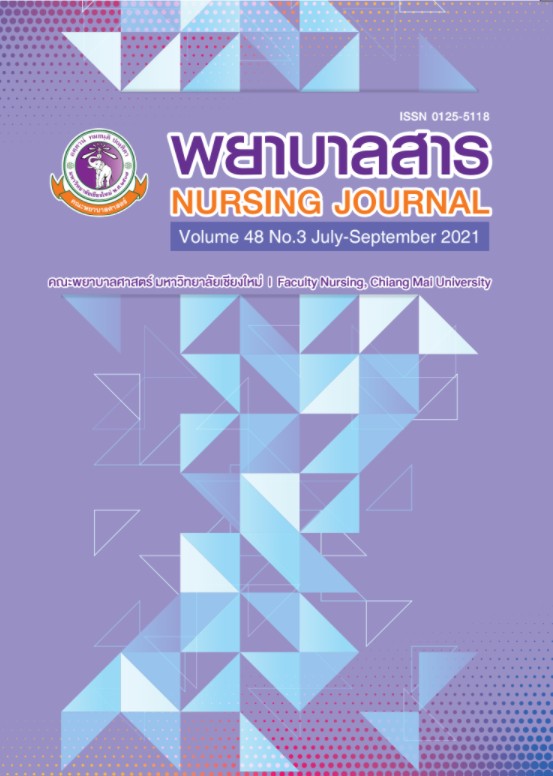สมรรถนะแห่งตนและการปฏิบัติงานด้านการปรับตัวของหัวหน้าพยาบาล ในโรงพยาบาล ในเครือของมหาวิทยาลัยต้าหลี่ สาธารณรัฐประชาชนจีน
คำสำคัญ:
สมรรถนะแห่งตน, การปฏิบัติงานด้านการปรับตัว, หัวหน้าพยาบาล, โรงพยาบาลในเครือของมหาวิทยาลัยต้าหลี่, สาธารณรัฐประชาชนจีนบทคัดย่อ
การรับรู้สมรรถนะแห่งตนและความสามารถในการปรับตัวเป็นองค์ประกอบที่สำคัญในระบบบริการสุขภาพเพื่อให้บรรลุผลลัพธ์เชิงบวกขององค์กร แต่อย่างไรก็ตามพบว่ามีการศึกษาเพียงเล็กน้อยเกี่ยวกับการศึกษาความสัมพันธ์ระหว่างความสามารถในการรับรู้สมรรถนะแห่งตนและความสามารถในการปรับตัว การศึกษาครั้งนี้เป็นการวิจัยเชิงพรรณนาหาความสัมพันธ์โดยมีวัตถุประสงค์เพื่อศึกษาการรับรู้สมรรถนะแห่งตนและความสามารถในการปรับตัวของหัวหน้าหอผู้ป่วย และ ศึกษาความสัมพันธ์ระหว่างการรับรู้สมรรถนะของตนกับความสามารถในการปรับตัวของหัวหน้าหอผู้ป่วย ในโรงพยาบาลในเครือของมหาวิทยาลัยการแพทย์ ต้าลี่ สาธารณรัฐประชาชนจีน กลุ่มตัวอย่างเป็นหัวหน้าหอผู้ป่วยจำนวน135 คนที่ปฏิบัติงานในโรงพยาบาลมหาวิทยาลัย 4 แห่งในจังหวัดยูนนานสาธารณรัฐประชาชนจีน เครื่องมือที่ใช้ในการวิจัย ประกอบด้วยแบบประเมินประสิทธิภาพการรับรู้ตนเองโดยทั่วไป (General Self-Effective Scale: GSES) ที่พัฒนาขึ้นโดย Zhang & Schwarzer(1995) และแบบวัดสมรรถนะในการปรับตัวAdaptive Performance Scale ที่พัฒนาขึ้นโดย Charbonnie-Voirin et al. (2012) ที่แปลเป็นภาษาจีนโดยผู้วิจัยโดยไม่มีการดัดแปลง การทดสอบค่าสัมประสิทธิ์ความเชื่อมั่นของของครอนบาคของเครื่องมือ GSES และ Adaptive Performance Scale เท่ากับ .86 และ .89 ตามลำดับ การวิเคราะห์ข้อมูลโดยใช้สถิติเชิงพรรณนาและสัมประสิทธิ์สหสัมพันธ์ของเพียร์สัน
ผลการศึกษาพบว่า ความสามารถในการรับรู้สมรรถนะแห่งตนของหัวหน้าหอผู้ป่วยอยู่ในระดับ
ปานกลาง (x=2.81, SD = 0.49) และความสามารถในการปรับตัวของหัวหน้าหอผู้ป่วยอยู่ในระดับสูง (x=5.59, SD=0.56) การรับรู้สมรรถนะแห่งตนของหัวหน้าหอผู้ป่วยมีความสัมพันธ์เชิงบวกในระดับปานกลางกับการปรับตัว (r = .495, p <.01)
ผลการศึกษาครั้งนี้สามารถนำไปเป็นข้อมูลพื้นฐานและความรู้สำหรับผู้บริหารโรงพยาบาลในการพัฒนานโยบายและกลยุทธ์การบริหารของโรงพยาบาล เพื่อช่วยเพิ่มประสิทธิภาพในการรับรู้สมรรถนะแห่งตนของหัวหน้าหอผู้ป่วย ซึ่งจะช่วยเพิ่มความสามารถในการปรับตัวของหัวหน้าหอผู้ป่วย
เอกสารอ้างอิง
Andela, M., Truchot, D., & Van der Doef, M. (2016). Job stressors and burnout in hospitals: The mediating role of emotional dissonance. International Journal of Stress Management, 23(3), 298.
Bouwens, J., & Krueger, D. (2014). Embracing Change: The healthcare industry focuses on new growth drivers and leadership requirements. Retrieved from http://www. russell reynolds. com/content/embracing-change healthca.
Charbonnier-Voirin, A., & Roussel, P. (2012). Adaptive performance: A new scale to measure individual performance in organizations. Canadian Journal of Administrative Sciences/Revue Canadienne des Sciences de l’Administration, 29(3), 280-293.
Charbonnier-Voirin, A., El Akremi, A., & Vandenber, C. (2010). A multilevel model of transformational leadership and adaptive performance and the moderating role of climate for innovation. Group & Organization Management, 35(6), 699-726.
Deng, F. F. (2015). Comparison of nursing education among different countries. Chinese Nursing Research, 2 (4), 96-98.
Du, C., & Wang, Z. (2012). Research on the relationship between personality traits, general self-efficacy and adaptability performance of employees. Soft Science, 26 (4), 101-1059. (in Chinese)
Dorsey, D., Cortina, J., & Luchman, J. (2010). Adaptive and citizenship-related behaviors at work. In J. Farr, & N. Tippins (Eds.), Handbook of employee selection (463–487). New York, NY: Routledge/Taylor & Francis Group.
Griffin, M., Neal, A., & Parker, S. (2007). A new model of work role performance: Positive behavior in uncertain and interdependent contexts. Academy of management journal, 50(2), 327-347.
Health and Family planning commission of Yunnan PR. (2017). The workload of medical service in Yunnan Province. Retrieved from http://www.pbh.yn.gov.cn
Ilgen, D. R., & Pulakos, E. D. (1999). Employee performance in todays organizations. In D. R.
Ilgen & E. D. Pulakos (Eds). The changing nature of work performance: Implications for
staffing, motivation, and development. San Francisco: Jossey-Bass, 2, 165-208.
Israel, G. D. (1992). Determining Sample Size. PEOD6. IFAS extension, University of
Florida. Kirk, R (2007). Statistics: An introduction. New York: Thomson Learning.
Liang, J., & Tan, C. (2016). Investigation and analysis of occupational stress of emergency nurses in pre – hospital. Attend to Practice and Research, 23(12), 83-84. (in Chinese)
Liu, H. H. (2014). A study on the self-efficacy and turnover intention of operating
room nurses in Zhuzhou city (Master’s thesis) Central South University.
Luszczynska, A., & Schwarzer, R. (2005). Social cognitive theory. In M. Conner & P. Norman (Eds.), Predicting health behaviour (2nd ed. rev.,127–169). Buckingham, England: Open University Press.
Luthans, F. (2002). Positive organizational behavior: Developing and managing
psychological strengths. Journal of Management Executive, 16, 57-75.
Marques-Quinteiro, P., Ramos-Villagrasa, P., Passos, A., & Curral, L. (2015). Measuring adaptive performance in individuals and teams. Team Performance Management, 21(7),339-360.
Naami, A., Behzadi, E., Parisa, H., & Charkhabi, M. (2014). A study on the personality aspects of adaptive performance among governmental hospitals nurses: A conceptual model. Procedia-Social and Behavioral Sciences, 159, 359-364.
National health and family planning commission. (2015).The National Planning Guideline for the Healthcare Service System (2015–2020). Retrieved from
http://www.nhfpc.gov.cn/mohwsbwstjxxzx/s8555/201504/
ba436861e04a848e05e3f3216a4b7a.shtml.
Ning, L., Li, Y., Lu, J., & Lin, L, J. (2013). A study on the relationship between job burnout, role
perception and self-efficacy among 112 head nurses in Hangzhou. Journal of Nursing, 11, 71-73.
Schwarzer, R. (1994). Optimism, vulnerability, and self-beliefs as health-related cognitions: A systematic overview. Psychology and health, 9(3), 161-180.
Schwarzer, R., & Jerusalem, M. (1995). Generalized Self-Efficacy Scale. In J. Weinman, S.
Wright, & M. Johnston (Eds.), Measures in health psychology: A user’s portfolio. Causal
and control beliefs (pp. 35-37). Windsor, UK: NFER-NELSON.
Sibthorpe, B., & Glasgow, N., and Longstaff, D. (2004). Complex adaptive systems: A different way of thinking about Health care systems. The Australian National University.
Retrieved from https://www.betterevaluation.org/en/resources/overview/complex_adaptive_systems
Wakim, N. (2014). Occupational stressors, stress perception levels, and coping styles
of medical surgical RNs: A generational perspective. Journal of Nursing Administration, 44(12), 632-639.
Wu, X., Li, X., Wang, Y., & Li, J. (2014). A study on the relationship between time management tendency and self-efficacy of head nurses. Journal of Nursing, 7-10. (in Chinese)
Xenikou, A., & Simosi, M. (2006). Organizational culture and transformational
leadership as predictors of business unit performance. Journal of managerial psychology, 21(6), 566-579.
Yamane, T. (1973). Statistic: An introductory analysis. Tokyo: Harper International.
Zacher, H. (2014). Patient Safety-A Psychological Perspective: Berlin, Boston: De Gruyter. doi.org/10.1515/9783110281927
Zhang, J., Wang, W., Hong, J. F., & Wang, J. X. (2014). Survey and analysis on core
competence of nurse managers. Nursing research, 28(1), 290-292.
Zhang, J. X., & Schwarzer, R. (1995). Measuring optimistic self-beliefs: A Chinese adaptation of
The General self-efficacy Scale. psychologia: An international Journal of Psychology in
the Orient, 38(3), 174–181.
ดาวน์โหลด
เผยแพร่แล้ว
รูปแบบการอ้างอิง
ฉบับ
ประเภทบทความ
สัญญาอนุญาต
บทความที่ได้รับการตีพิมพ์เป็นลิขสิทธิ์ของวารสารพยาบาลสาร
ข้อความที่ปรากฏในบทความแต่ละเรื่องในวารสารวิชาการเล่มนี้เป็นความคิดเห็นส่วนตัวของผู้เขียนแต่ละท่านไม่เกี่ยวข้องกับมหาวิทยาลัยเชียงใหม่ และคณาจารย์ท่านอื่นๆในมหาวิทยาลัยฯ แต่อย่างใด ความรับผิดชอบองค์ประกอบทั้งหมดของบทความแต่ละเรื่องเป็นของผู้เขียนแต่ละท่าน หากมีความผิดพลาดใด ๆ ผู้เขียนแต่ละท่านจะรับผิดชอบบทความของตนเองแต่ผู้เดียว






